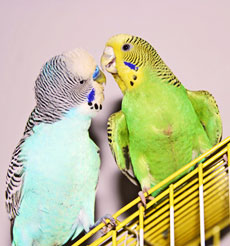
A Parakeet is any of a number of small parrots that are often kept as cage birds. Its name literally means “small parrots”. Parakeets come in a large variety of colors including pastel blue, yellow, dark green, violet, solid white and an almost limitless combination of these said colors. They can be found throughout the world but a true Parakeet is native to Southeastern Asia.
Parakeets as Pets
Parakeets range from about 7 to 12 inches in length. They have a heavy curved bill and long-toed feet like other parrots. Most of them have long pointed tails.
Caring for one’s parakeet is the most important aspect of having this bird as a pet. Standard care would involve consulting a veterinarian at the first sign of illness. It also means regular check-up of their plumage as well as considering all other factors like the choice and positioning of cage, training, grooming, food, water and toys among other.
One striking characteristic of Parakeet behavior is the communal nest building. Parakeets will do poorly when placed together with other species of parrots. To do so would be like a punishment for them. This particular Parakeet behavior is known as solitary keeping which sometimes lead to communication problems and other behavioral problems. Parakeet owners sometimes have to contend with certain peculiarities of pet Parakeets which are easily remedied with the right information.
Parakeets are intelligent so there is not much problem with regards to training. They can be taught to talk, perform tricks or perch on one’s hand, shoulder or head with a little patience and time. The first step in parakeet training is to get the bird used to the hand of its owner or trainer.
When doing this for the first couple of times, the trainer should be very careful as not to scare the Parakeet as it might react by biting. Whatever happens, the trainer should always remain calm and never resort to yelling at the bird. Parakeets are loving and social creatures. A hand-trained Parakeet enjoys gentle petting as well.
For optimum Parakeet health, there are some things that should be absolutely provided. These are a cage with a cover, food and water dishes as well as cuttlebone, Parakeet food and a bird toy. Nutrition is probably the most important aspect of this bird’s health.
The cage should be kept clean and should be large enough to allow for plenty of exercise. It should be placed off the floor in a secure, peaceful and preferably low traffic area. Other places to avoid are those that are in direct sunlight or in the path of a heating or air-conditioning vent. The positioning of the cage largely determines whether one’s pet Parakeet will be healthy and playful or lonely and depressed. A toy is also a vital part of a Parakeet’s life and if there is one must- has for this bird, it would be the bell.
Parakeets get sick without any warning. The usual manifestations of illness would include ruffled plumage, resting often with its head tucked under the wing or rump, not eating and discharge from the nostril and mouth and cloudy eyes. The owner should have a basic knowledge of the various cures and medications that can be undertaken when unable to immediately consult a vet but should be taken to one as soon as possible.
Food should comprise of a large variety of grain and millet seeds plus some variations like peas, carrots, tomatoes, apples, bananas and the like. Freshwater is needed everyday and the water dish should be cleaned daily as well. Special treats can also be offered such as popcorn on a stick or honey sticks. A cuttlebone should also be at hand to provide calcium for strong bones and iodine to prevent goiter.